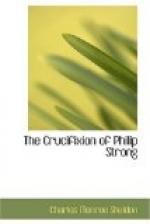Philip was on the point of asking his strange guest to tell something of his history, but his great weariness and the knowledge of the strength needed for his Sunday work checked the questions that rose for answer. Mrs. Strong also came in and insisted that he should get the rest he so much needed. She arranged a sleeping-place on the lounge for the Brother Man, who, after once more looking in upon his son and assuring himself that he was resting, finally lay down with a look of great content upon his beautiful face.
In the morning Philip almost expected to find that his visitor had mysteriously disappeared, as on the other occasions. And he would not have been so very much surprised if he had vanished, taking with him in some strange fashion his newly discovered son. But it was that son who now kept him there; and in the simplest fashion he stayed on, nursing the sick man, who recovered very slowly. A month passed by after the Brother Man had first found the lost at Philip’s house, and he was still a guest there. Within that month great events crowded in upon the experience of Mr. Strong. To tell them all would be to write another story. Sometimes into men’s lives, under certain conditions of society, or of men’s own mental and spiritual relation to certain causes of action, time, as reckoned by days or weeks, cuts no figure. A man can live an eternity in a month. He feels it. It was so with Philip Strong. We have spoken of the rapidity of his habit in deciding questions of right or expediency. The same habit of mind caused a possibility in him of condensed experience. In a few days he reached the conclusion of a year’s thought. That month, while the Brother Man was peacefully watching by the side of the patient, and relieving Mrs. Strong and a neighbor who had helped before he came, Philip fought some tremendous battles with himself, with his thought of the church, and with the world about. It is necessary to understand something of this in order to understand something of the meaning of his last Sunday in Milton—a Sunday that marked an era in the place, from which the people almost reckoned time itself.
As spring had blossomed into summer and summer ripened into autumn, every one had predicted better times. But the predictions did not bring them. The suffering and sickness and helplessness of the tenement district grew every day more desperate. To Philip it seemed like the ulcer of Milton. All the surface remedies proposed and adopted by the city council and the churches and the benevolent societies had not touched the problem. The mills were going on part time. Thousands of men yet lingered in the place hoping to get work. Even if the mills had been running as usual that would not have diminished one particle of the sin and vice and drunkenness that saturated the place. And as Philip studied the matter with brain and soul he came to a conclusion regarding the duty of the church. He did not pretend to go beyond that, but as the weeks went by and fall came on and another winter stared the people coldly in the face, he knew that he must speak out what burned in him.




